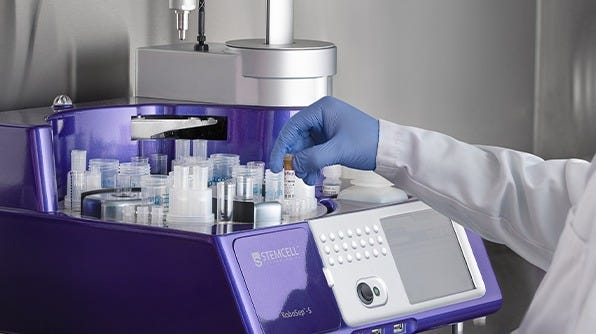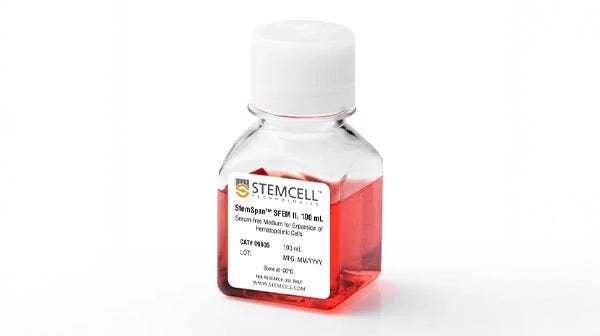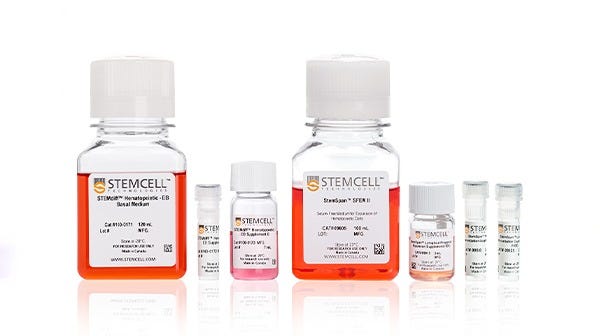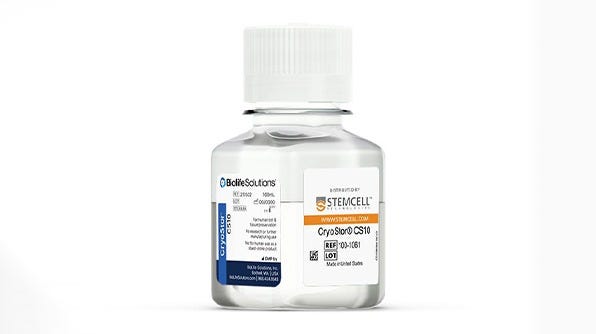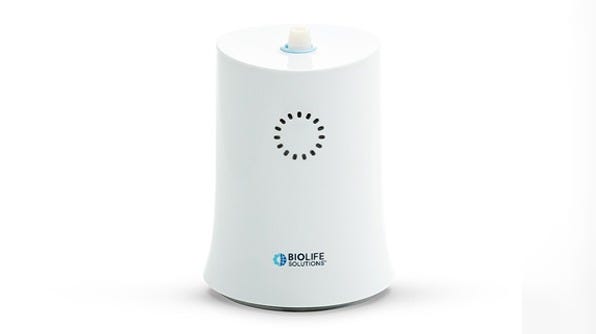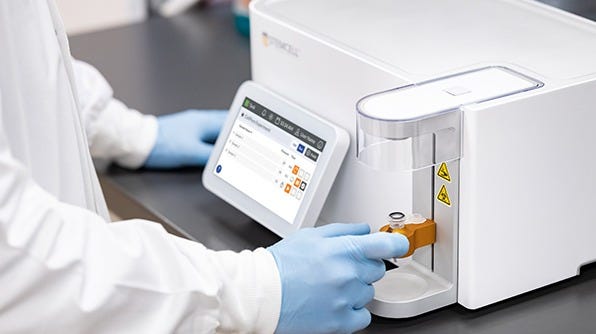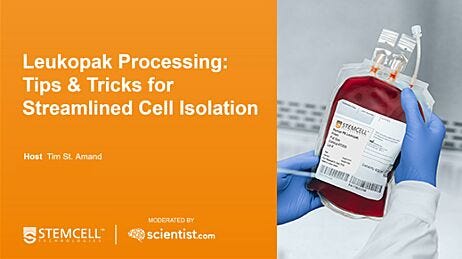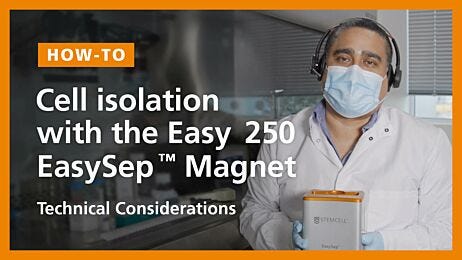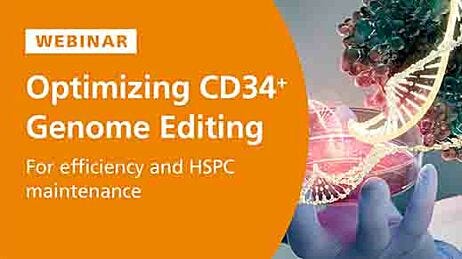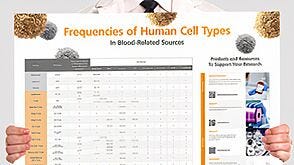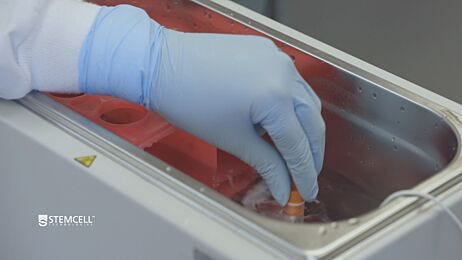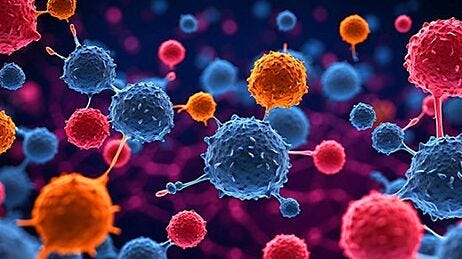Efficient Large-Scale Cell Workflow Solutions
Tips and Tools for Sourcing and Isolating Cells from Large-Volume Samples
Why Scale Up?
Workflows for large-scale biomedical research, including drug discovery and the development of cell-based vaccines and therapeutics, require significantly larger quantities of starting biological materials than conventional research methodologies. Thus, strategies for large-scale research must consider how to increase the collection, processing, and analysis of specific cell types at scale for downstream applications. The resultant standardized, scalable workflows may then enable researchers to more effectively understand complex cellular phenomena and a faster transition from bench to clinic.
Choosing large-scale human primary cell sources such as peripheral blood (PB) leukopaks, whole blood, or mononuclear cells (PBMCs) as starting sources is one key step toward scalable workflows. Another way to increase efficiency is to scale up cell separation processes so that a large number of cells can be isolated from one or multiple sources in the fewest steps. Large-scale cell isolation can support accelerated drug discovery and immunotherapy development by enabling researchers to spend less time isolating cells and more time on their downstream experiments.
Additional benefits of large-scale cell cell sourcing and isolation include:
- Reduced biological variability of results: Using cells isolated from the same donor instead of multiple donors reduces biological variability and increases the reproducibility of results in cell assays. In the context of drug discovery and finding therapy candidates, using the same donor ensures that the obtained results are due to the therapy candidate and not due to biological differences in donors.
- Fewer donors required: Isolating large numbers of cells from specific donors reduces the need to keep searching for more donors who meet the desired criteria.
- Fewer isolations needed when establishing cell banks: Obtaining sufficient cells to bank for future experiments avoids the need to repeat cell isolations later on.
- Time savings: Researchers can skip the labor-intensive steps of cell isolation and validation, focusing more on experimentation and data analysis rather than preparatory work.
Ultimately, scaling up provides solutions for obtaining a large number of cells in an efficient manner, with further downstream benefits, to promote high-quality results and advancements in cell therapy and drug discovery research.
Considerations When Scaling Up Your Workflows
To assess whether you should integrate scalable cell sources and cell isolation technologies into your workflows, consider the following questions:
- Do constraints in high-quality cell availability affect your experiments?
- How does donor-to-donor variability affect your research outcomes?
- How long does it take you to process large-volume samples and obtain cells?
- How frequently do you process large-volume samples?
- Does the length of your current cell isolation protocol limit the number of important experiments you can complete in a day?
- Is your current cell isolation protocol negatively affecting the quality of your cells?
- Are there other approaches or methods that could streamline the process, reduce costs, and improve cell quality?
If you frequently handle large sample volumes, struggle with donor variability, or experience workflow inefficiencies, integrating large-scale cell sources and isolation technologies can enhance your research. These solutions improve reproducibility and efficiency and can help ensure you get the high-quality cells you need for reliable experimental outcomes.
Large-scale cell sources help mitigate certain issues by offering batch-controlled, well-characterized donor cells to improve assay validity, maintain consistency, and accelerate research progress.

Downstream, processing large-volume samples doesn’t have to be time-consuming or complex. Commercially available technologies exist that are fast and easy to use, helping you maximize your throughput when processing large-volume samples. These platforms eliminate the need to split your sample, enabling you to perform your cell isolations in fewer steps and with less reagents. Additionally, these platforms are flexible; they still allow you to isolate cells from smaller samples, but once you are ready to increase your sample size, you can use the same platform and reagents for larger-volume cell processing.
In general, if you're frequently processing large-volume samples, switching to a high-throughput cell isolation method can be more efficient and cost-effective and may have other beneficial effects on the quality of your cells. By optimizing your workflow for scale, you can achieve more reliable and reproducible results with greater ease.
About Cost-Effectiveness
In some cases, it may appear that using the most inexpensive reagents will be the most cost-effective solution. However, to determine the real cost of a specific technique, it is also important to consider indirect costs such as technologist time, staff training time, user-to-user variability, and expenses associated with increased turnaround time.
Scalable Cell Sourcing
Human primary cells are an efficient and integral tool for researchers aiming to reduce extensive in vivo validation and facilitate their translation of basic research into preclinical or clinical applications. Scale up your primary cell-based research by using large-scale peripheral blood sources such as whole blood or leukopaks. These single-donor cell sources increase the physiological relevance of cell culture systems, enabling you to generate meaningful data that is more predictive of in vivo outcomes. Bulk primary cells, including PBMCs and leukopaks, are actively being used for flow immunophenotyping, high-content screening, sequencing, disease modeling, toxicology, and in vitro vaccine development. Additionally, mobilized leukopaks are a great source of CD34+ cells, which enable researchers to perform ex vivo expansion, differentiation studies, regenerative medicine, and gene therapy.
Why Use Human Primary Cells from STEMCELL Technologies?
- Choose cells that are more physiologically representative of cells in vivo.
- Access donor samples collected using regulatory authority-approved consent forms and protocols.
- Request custom products for non-standard cell types or collections with specific requirements.
- Reserve large numbers of cryopreserved cells and start experiments on your schedule with cells you’ve already tested.
- Reduce time spent collecting and culturing primary cells.
Learn more about how we can work closely with you as your human primary cells supplier.
Products for Your Large-Scale Cell Sourcing
STEMCELL offers a comprehensive collection of large-volume cell sources, including cryopreserved or fresh PB leukopaks or leukapheresis products*, whole blood, and PBMCs to support your research needs. Ensure continuity in your research and start experiments according to your schedule with a reliable supply of high-quality, single-donor sourced primary cells that are ready to use upon receipt.
Table 1. Comparison of Large-Volume Samples
(9 x 10^9 cells minimum)
*Data shown is for a fresh full Leukopak. This product is available in a range of sizes. See more here.
Note: The cell count will vary depending on the donor.
Our PB Leukopak Products Portfolio
Explore our range of ethically sourced human PB leukopak products to streamline your research. Leukopaks are shipped with a lot-specific Certificate of Analysis (CoA) indicating the guaranteed viability and purity of your product. *Certain products are only available in select territories. Please contact your sales representative or the Product & Scientific Support team at techsupport@stemcell.com for further information.
Fresh Normal
Get large numbers of fresh single-donor cells in a selection of fresh normal leukopaks.
Frozen Leukopaks
Obtain large numbers of cryopreserved single-donor PBMCs and begin experiments when you are ready.
Diseased Leukopaks
Use ethically sourced fresh leukopaks from donors diagnosed with a specific autoimmune, inflammatory, solid tumor or hematological cancer disease.
Human Mobilized Peripheral Blood Leukopak, Fresh
Obtain large numbers of fresh single-donor CD34+ HSPCs from PB leukopaks mobilized with G-CSF, plerixafor, or a combination of.
Table 2. Minimum Cell Counts in Different Types of PB Leukopaks
| Size | Normal Fresh Leukopaks | Normal Frozen Leukopaks | Cancer Diseased Fresh Leukopaks* | Autoimmune or Inflammatory Diseased Fresh Leukopaks* |
|---|---|---|---|---|
| Full | ≥ 10 billion | ≥ 9 billion | - | ≥ 8 billion |
| Half | ≥ 5 billion | ≥ 5 billion | - | ≥ 4 billion |
| Quarter | ≥ 2.5 billion | ≥ 2.5 billion | - | - |
| Tenth | ≥ 1 billion | ≥ 900 million | ≥ 1 billion | - |
*Note: The cell count can vary greatly based on the disease (autoimmune, respiratory, cancer, etc.)
Mobilized Leukopaks do not have a minimum cell count specification as the cell count can vary greatly due to donor variability and the mobilizing agent. On average, the cell count for a mobilized leukopak could be 2 - 6 times more than a normal fresh leukopak based on the donor and mobilizing agent.
Other Large-Scale Cell Sources
Whole Peripheral Blood
Isolate immune cells from peripheral whole blood samples, available in small volumes (< 100 mL) and large volumes (≥ 450 mL), collected and supplied in 10 mL Vacutainer® tubes and collection bags, respectively.
Peripheral Blood Mononuclear Cells
Choose PBMCs from thousands of batches of HLA-typed cells in convenient sizes and with extensive flow cytometry data available. Large quantities are reservable to ensure consistency across your experiments.

Figure 1. Mean Percentages of Cell Subpopulations in a Frozen Leukopak and Cryopreserved PBMCs
(A) Representative chart showing the average frequencies of major immune subsets in leukopak products, as measured by flow cytometry before cryopreservation. Values shown are mean percentages of total viable leukocytes present in a frozen leukopak (n ≥ 30). Actual percentages will vary from donor to donor. For all frozen leukopaks, the exact frequency of these cell types in the leukopak you receive will be provided as a flow plot on the Certificate of Analysis; frequency data is available at an additional fee for fresh leukopaks. (B) Representative chart showing the average frequencies of major immune subsets in cryopreserved PBMC products, as measured by flow cytometry post-thaw. Values shown are mean percentages of total viable leukocytes present in PBMCs (n ≥ 183).
Request an Offer for Human Primary Cells
Fill out this form to request information about introductory offers to try STEMCELL’s human primary cell products.
Frequently Asked Questions on Primary Cells
Find answers to frequently asked questions on our leukopaks and other primary cell products.
Contact our primary cells team or your sales representative to discuss your specific regulatory or custom product requirements.
Scalable Immunomagnetic Cell Isolation
Scaling up, in the context of cell isolation, involves transitioning to a platform that supports the processing and isolation of desired cells from large-volume samples to reduce the number of steps involved. Platforms that harness immunomagnetic cell isolation technology, such as EasySep™ and RoboSep™, can provide an efficient, scalable method of isolating highly purified cells from both small and large-volume samples that are ready for downstream applications.
With immunomagnetic cell isolation, the first step involves processing the large-volume sample into a single-cell suspension. The method you choose to prepare the single-cell suspension will depend on the cell type you want to isolate. Once you have the single-cell suspension, using a large-scale approach enables you to isolate a large number of desired cells in a single cell separation procedure. In contrast, the small-scale approach typically requires multiple rounds of cell isolation.

Figure 2. Large-Scale Cell Isolation Platforms Require a Fewer Number of Steps to Isolate Cells from Large-Volume Samples Compared to Small-Scale Cell Isolation Platforms
Products for Your Large-Scale Isolation Needs
The easy choice for simple cell isolation, the EasySep™ system includes cell separation magnets that harness immunomagnetic cell isolation technology to provide a fast and easy way of isolating cells from various samples.
Why Use EasySep™ to Isolate Cells from Large-Volume Samples?
- Isolate cells in as little as 20 minutes.
- Achieve up to 99% of cell purities with high recoveries.
- Obtain viable, functional cells without the need for columns and washes.
- Isolate cells from whole blood and leukopaks.
Easy 50 EasySep™ Magnet
In as little as 25 minutes, process up to 40 mL and 4 x 10^9 cells, with a single separation step, using the Easy 50 EasySep™ Magnet.
Easy 250 EasySep™ Magnet
In as little as 20 minutes, process up to 225 mL of sample and 1.25 x 10^10 cells , with a single isolation step, using the Easy 250 EasySep™ Magnet.
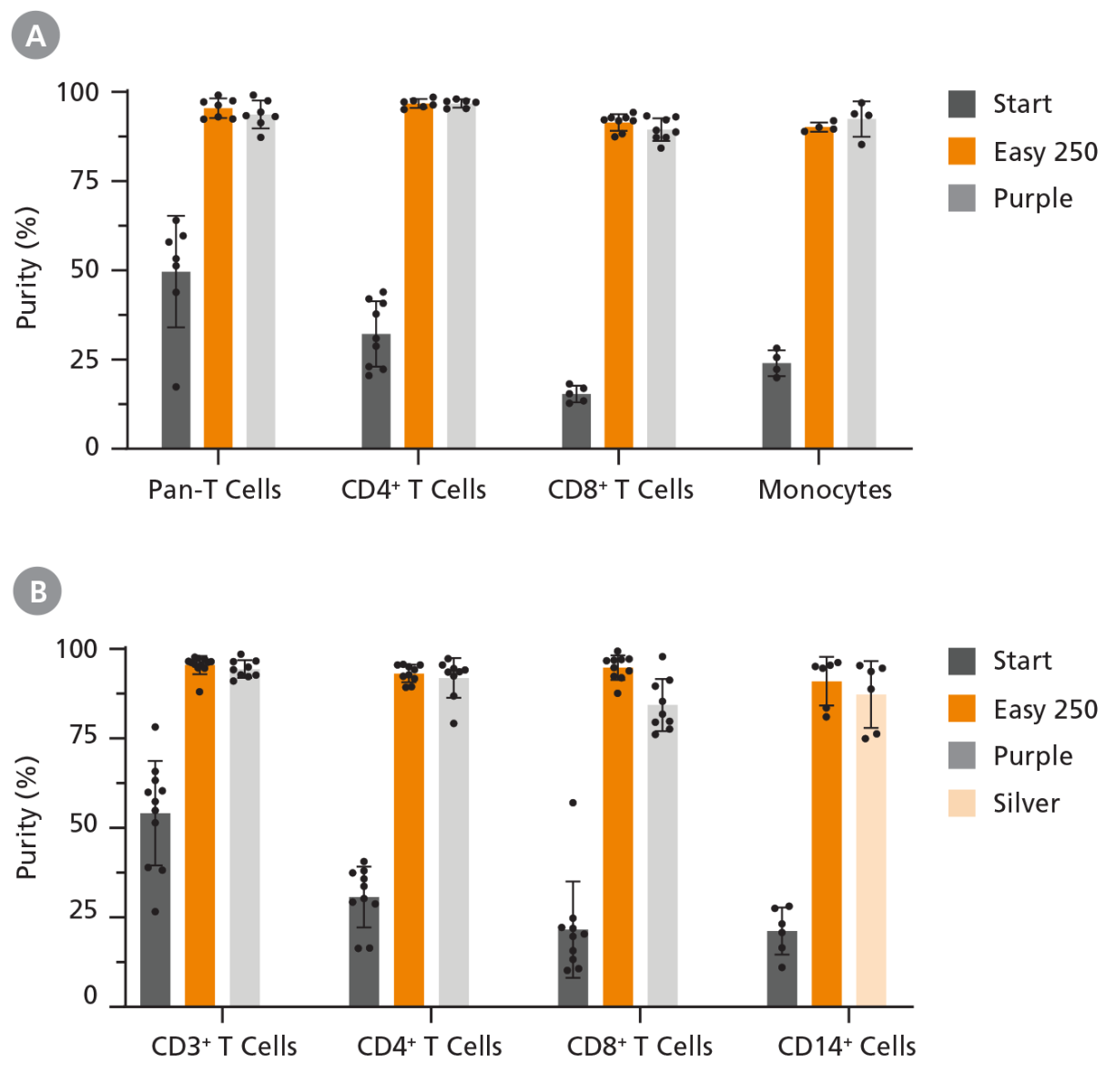
Figure 3. Using the Easy 250 EasySep™ Magnet Results in the Isolation of Highly Purified Cells of Interest
Human immune cells were isolated from processed leukopaks using the corresponding (A) EasySep™ negative selection kits or (B) EasySep™ positive selection kits. Cell purity was measured before isolation (Start) and after isolation with the Easy 250 EasySep™ Magnet (Easy 250), EasySep™ Magnet (Purple), or “The Big Easy” EasySep™ Magnet (Silver). Purity was assessed by staining with cell surface markers for pan-T cells (CD3+), CD4+ T cells (CD3+CD4+), CD8+ T cells (CD3+CD8+), or monocytes (CD14+CD45+), and analyzed by flow cytometry. Data shown as mean ± SD; n = 4 - 12.
Try it in your own lab!
Unsure if the Easy 250 EasySep™ Magnet is right for your research? Try it in your own lab to isolate human immune cells from samples of up to 225 mL.
Request a Demo >STEMCELL’s EasySep™ magnets are compatible with a wide range of cell isolation kits that are fast, easy-to-use, and highly integratable in a broad range of research fields.
My experience with the EasySep™ was seamless. The protocol is simple & quick, almost too easy, and has allowed me to successfully isolate my cells of interest with high purity. This gives me extra time to do other experiments and confidence in my data.
I do not have experience with other cell isolation products but I have no need to look elsewhere now as the EasySep™ is simple and does the job to perfection!
Matthew Cormier, PhD Candidate
Explore our Featured EasySep™ Publications to learn more about how researchers have used EasySep™ in a wide range of downstream applications such as flow cytometry, mass cytometry, next-generation sequencing, immune cell engineering, proteomics and metabolomics, and more!
Automate Cell Separation with RoboSep™
EasySep™ immunomagnetic isolation can also be automated using RoboSep™ instruments, offering true walk-away automation options for labs requiring higher throughput, providing the same ease and reliability on a larger scale. Minimize sample handling and perform simultaneous and sequential cell isolations from multiple samples using RoboSep™-S and RoboSep™-16 instruments.
Scalable Cell Culture and Expansion
Scaling up immune cell culture is essential for advancing cell-based therapies, vaccine development, and large-scale biomedical research. Choosing chemically defined, serum-free media is a simple method to help improve consistency and cell viability when trying to maintain optimal growth conditions at scale. Explore our cell culture media options for your applications below or inquire about custom solutions specifically designed for you.
Products for Your Immune Cell Culture Needs
StemSpan™
Selectively promote expansion of CD34+ stem and progenitor cells or stimulate their differentiation into lymphoid progenitors (T, B, or NK cells) or myeloid progenitors (monocyte or granulocyte).
STEMdiff™
Reproducibly differentiate multiple human embryonic stem and induced pluripotent stem cell lines into T cells, NK cells, monocytes, and microglia.
ImmunoCult™
Ensure optimal activation, expansion, and differentiation of immune cell subsets including T cells, B cells, NK cells, dendritic cells, and macrophages.
Downstream Workflow Solutions
Explore some of our cell processing technologies and resources to support the standardization of your large-scale cell culture workflows.
CryoStor™ CS10
Maximize post-thaw cell recovery and viability with serum-free, animal component-free, and GMP CryoStor® CS10 medium.
ThawSTAR® Automated Thawing Systems
Increase confidence in your cell thawing workflow and ensure sample sterility and consistent thawing performance by using the ThawSTAR® CFT2 Automated Thawing System. With a standardized thawing process that replaces manual, water bath-based thawing, ThawSTAR® CFT2 eliminates the risk of contamination and delivers controlled thawing profiles.
CellPore™
Achieve efficient cytosolic delivery of target cargoes into hard-to-transfect cells without altering cell quality by using our CellPore™ Transfection System. Enjoy superior viability and delivery compared to other cell transfection methods, all with minimal protocol adjustments and seamless integration into existing workflows.
Protocols and Resources for Your Cell-Based Assays
Discover protocols and technical resources to support your large-scale research workflows.












